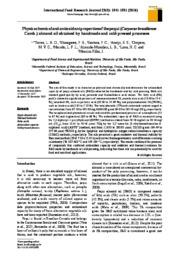Physicochemical and antioxidant properties of the pequi (Caryocar brasiliense Camb.) almond oil obtained by handmade and cold-pressed processes.
Physicochemical and antioxidant properties of the pequi (Caryocar brasiliense Camb.) almond oil obtained by handmade and cold-pressed processes.
Autoria: TORRES, L. R. O.; SHINAGAWA, F. B.; ARAÚJO, E. S.; OROPEZA, M. V. C.; MACEDO, L. F. L.; ALMEIDA-MURADIAN, L. B.; LIMA, H. C. de; MANCINI-FILHO, J.
Resumo: Abstract: The aim of this study is to characterize physical and chemically and determine the antioxidant capacity of pequi almond oils (PAO) extracted by handmade and by cold-pressing. Both oils showed good quality by acid, peroxide and thiobarbituric acid values. The fatty acid (FA) profile showed a significant presence of monounsaturated FA, mainly oleic acid (53.48 to 55.41%); saturated FA, such as palmitic acid (33.30 to 35.89 %); and polyunsaturated FA (PUFA), such as linoleic acid (5.85 to 7.23%). The total phenolic (TP) and carotenoid content ranged in concentration from 87.56 to 392.00 mg GAE/100 g and 36.03 to 262.40 mg/100 g, respectively. The tocopherol and phytosterol results indicated the predominant presence of α-tocopherol (52 to 67%) and stigmasterol (63 to 68 %). The antioxidant capacity of PAO as measured using the 2,2-diphenyl-1-picrylhydrazyl (DPPH?) method oscillated from 58.48 mg/mL to 76.46 mg/mL (IC50), from 10.61 to 40.46 µmol TE/g by the 2,2′-azino-bis (3-ethylbenzothiazoline-6-sulphonic acid) (ABTS?+) method, and from 113.93 to 280.85 µmol TE/100 g and 164.49 to 277.86 µmol TE/100 g, by the lipophilic and hydrophilic oxygen radical absorbance capacity (ORAC) methods, respectively. The oils presented a good oxidative and thermal stability by Rancimat method (IP of 7.33 a 15.91 h) and curves thermogravimetric and differential scanning calorimetry (To 337-363 °C and 159-184 °C, respectively). The results confirmed the presence of compounds that conferred antioxidant capacity and oxidative and thermal resistance for PAO made by handmade or cold-pressing, indicating that these oils can potentially be used for food and non-food applications.
Ano de publicação: 2016
Tipo de publicação: Artigo de periódico
Unidade: Embrapa Cerrados
Palavras-chave: Almond oil, Antioxidante, Pequi, Prensado a frio, Processo artesanal, Propriedade Físico-Química, Óleo de amêndoa
Observações
1 - Por padrão são exibidas publicações dos últimos 20 anos. Para encontrar publicações mais antigas, configure o filtro ano de publicação, colocando o ano a partir do qual você deseja encontrar publicações. O filtro está na coluna da esquerda na busca acima.
2 - Para ler algumas publicações da Embrapa (apenas as que estão em formato ePub), é necessário ter, no celular ou computador, um desses softwares gratuitos. Sistemas Android: Google Play Livros; IOS: iBooks; Windows e Linux: software Calibre.
Acesse outras publicações
Acesse a Base de Dados da Pesquisa Agropecuária (BDPA) para consultar o acervo completo das bibliotecas da Embrapa.

